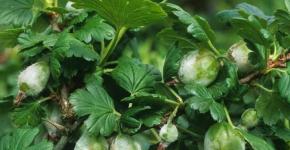Different types of radish: oil radish, daikon radish
Worldwide. For many centuries, peoples have appreciated its characteristic taste, nutritional properties and its healing qualities. The culture is quite unpretentious. Breeders from different countries are constantly working to create new species and varieties.
Types of radish
Different sources give different information about the number of radish species. Part of them:
White radish -Raphanus candidus Worosch.
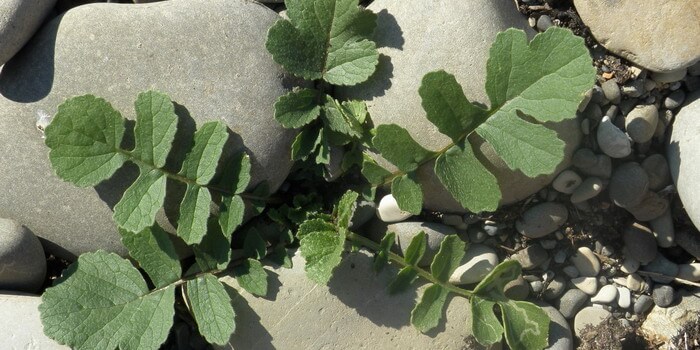
Seaside radish -Raphanus maritimus Sm.
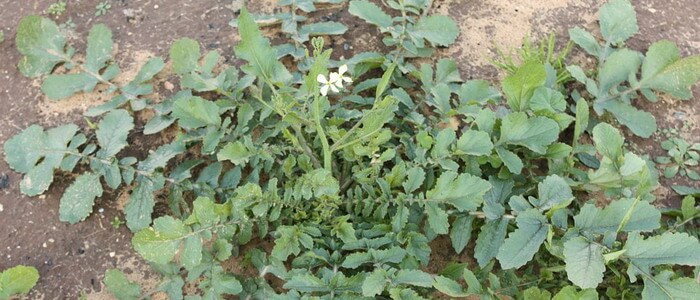
Wild radish(she - Field radish) — Raphanus raphanistrum L.

Sowing radish, Garden radish, Radish -Raphanus sativus L.
Some experts classify them as groups of varieties, others as varieties. Among the groups of plants of this species, the most famous are Margelan radish (“loba” or “lobo”), black radish, daikon.
Oil radish
The oil radish is an annual plant in the Cruciferous family. It can reach a height of 2m. Cold-resistant, shade-tolerant and moisture-loving. Able to give a large harvest. The flowers are white - purple in color. From the moment of germination to the moment of flowering, it takes about 40 days. The best time to plant seeds is June-July. Optimum depth for sowing seeds: 2-3 cm.

The plant adapts well to a wide variety of conditions. It is grown on any soil. Drought tolerant. For this reason, the process of growing it is not very difficult. In addition, the plant does not require a large amount. An overgrown crop can be used as compost. Due to the rapid growth, the radish is capable of clogging, actively suppresses nematodes. In vineyards, it can stimulate the growth and development of the vine.
Margelan or Chinese radish
Margelan radish, which is also often called Chinese radish, as well as "Loba" or "Lobo". Its roots are juicy and dense. They can be round or elongated. They occupy a middle place between daikon and between European varieties. "Loba" is stored worse than European varieties and its pulp is not so weakly pungent. All its varieties and hybrids are salads. Root vegetables can be different in color. Pink-red, light green, lilac-purple, dark green. But the top of the heads, in any case, has an intense green color. The roots are neither bitter nor pungent. Elderly people and people suffering from liver and heart diseases can eat them. "Loba" stimulates appetite, activates intestinal peristalsis. It is advised to use it for kidney stones or stones in the bladder, gout, scurvy, cough. "Loba" is used as an antiseptic - for the treatment of purulent ulcers and wounds. And as a local sedative - for neuritis, radiculitis and muscle pain.
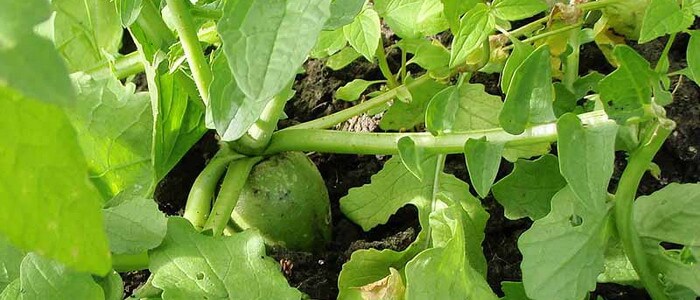
Root vegetables contain many beneficial and nutritious substances. Mineral salts, carotene, vitamins, calcium, magnesium. Essential oils, fiber, proteins, enzymes.
"Loba" removes cholesterol, toxins, salt from the body.
It is best to plant it after legumes, potatoes, onions and tomatoes. The seeds must be full. It is better to sow them in the second half of summer. In this case, the risk of the appearance of early peduncles is reduced. The plant is demanding on moisture. Regular watering is especially important during the formation and formation of root crops. In dry weather, regular watering is required.
The highest yield can be obtained on fertile soils. The plant responds well to organic fertilizers. Planting care is to prevent thickening. In addition, you should protect them from pests. The beds must be kept clean.
The best varieties: Zareva, Fang of an elephant, Margelanskaya, Oktyabrskaya-1. Pink ring, Oktyabrskaya-2, Severyanka 9809457, Troyandova.
The Red Heart variety can be distinguished separately. It has a light green surface. And its inside is very similar to a watermelon. The pulp is soft, juicy, practically without bitterness. You can store the harvest all winter.
Black radish
Black radish loses compared to other varieties in its taste, but at the same time its medicinal properties are highly valued. She uses roots and seeds. A biennial plant forms a root crop in the first year, seeds in the second. The root crop usually grows in weight 2-3 kg. The plant blooms in April - May. Root crops ripen a month after flowering. They treat arthritis, dispersions, coughs.
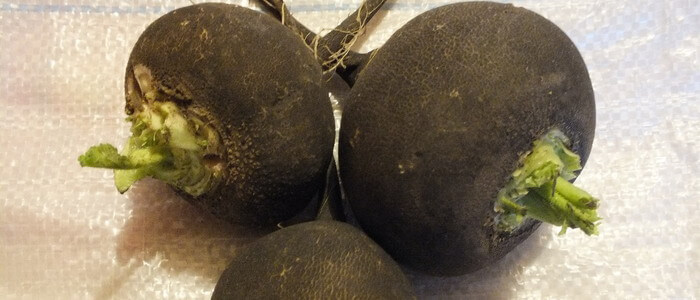
It is rich in enzymes, carotene, vitamin C, choline, magnesium, essential oils, proteins, fats. She was popular with the ancient Egyptians. The pyramid builders generously added it to their diet. Other varieties are also used to combat many diseases, but black is considered the most effective.
Green radish
Green radish is not as valued for its medicinal properties as black radish, but it is also quite useful. Its taste is more delicate and pleasant. She comes from Uzbekistan.
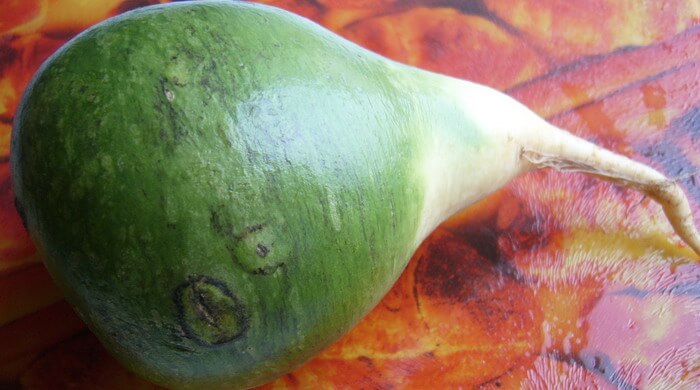
It is rich in amino acids, vitamins, carotene, phytoncides, sodium, phosphorus, potassium. Sulfur, essential oils, calcium. It can support a weakened immune system and improve well-being. It helps with coughs, bronchitis, dysbiosis, colds, whooping cough, improves bowel function. It removes cholesterol from the body, destroys microbes, has bactericidal properties. Improves appetite. Rub the body with grated gruel for muscle inflammation, neuritis, gout and rheumatism.
Daikon radish is a large white radish
The daikon plant is gaining more and more popularity. In Russia it is called "white radish". Sometimes "white radish" - it is a "relative" of both of them. The root vegetables of the daikon radish can be up to 60 cm long. Their diameter is 5 - 10 cm. They are valued for their unpretentiousness, excellent taste and healing properties. Only 100 g of the root contains 40% of the daily requirement of vitamin C. Daikon is also rich in other vitamins, sulfur, beta - carotene, folic acid, magnesium and copper. Potassium, iron, selenium, iodine, fiber. It strengthens the body remarkably. Improves digestion, dissolves kidney and gallstones. Daikon phytoncides fight germs and also slow down the growth of dangerous bacteria. Prolonged use of raw root vegetables improves heart function and cleanses blood vessels, relieves the body of cholesterol.
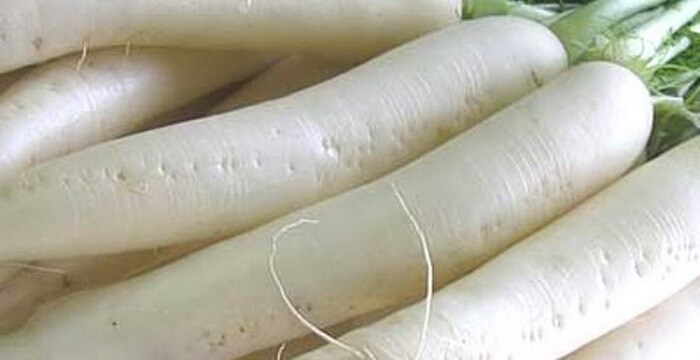
A distinctive feature of daikon is that when it is grown in dirty soil, it accumulates little harmful substances in itself. Three times less than other vegetables - for example, than carrots or beets. It is believed that eating it raw will neutralize the radioactive effect.
If you cut the daikon into thin slices and sprinkle with sugar, then after a while it will give a delicious juice. For lactating women, this juice will help improve lactation. If you mix warm juice and honey, you get an excellent remedy for bronchitis. Root vegetables are useful, but it is better to consult a doctor before using it.
They eat not only the root, but also seeds and greens. The seeds are germinated, the green leaves are added to salads. The root is boiled, baked, pickled, fried, added to soups and cabbage soup. Prepared as an independent dish.
It is added to rice dishes, sushi and sandwiches. The pickled fruits are called takuan. According to legend, the monk Soho Takuan came up with this way to save root crops for the winter.
It is best to consume the crop immediately after harvest. Nutrients are quickly lost. But a daikon can lie in a plastic bag in a refrigerator for several days.
Wild radish
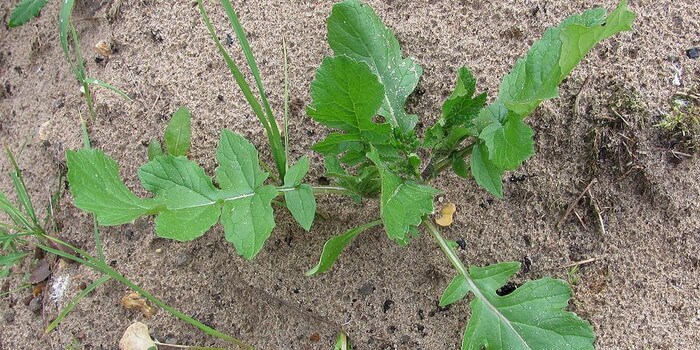
Wild radish is common in all Central Russian regions. It is an annual herb. It is considered a good honey plant. Weedy. It is found in fields, wastelands, in vegetable gardens. Its branchy stem, pubescent with simple hairs, reaches a height of 15 to 70 cm. The root of the plant is thin. The leaves are lyre-pinnately dissected, covered with hard hairs. Petals are yellow, rarely white. Flowering occurs in May - August. The plant bears fruit in June-September. The fruits are pods with a long nose. When they are ripe, the pods break down into separate segments.
Sweet radish
The vegetable is characterized by its bitterness and pungency. But, nevertheless, you can find sweet root vegetables. Most often they are bred and grown in China and Japan. For example, the Sakurajima variety. It allows you to collect huge sweet roots up to 16 kg. He is a masterpiece of world selection. Daikon and forehead are considered sweet radish. They contain almost no bitter oil.
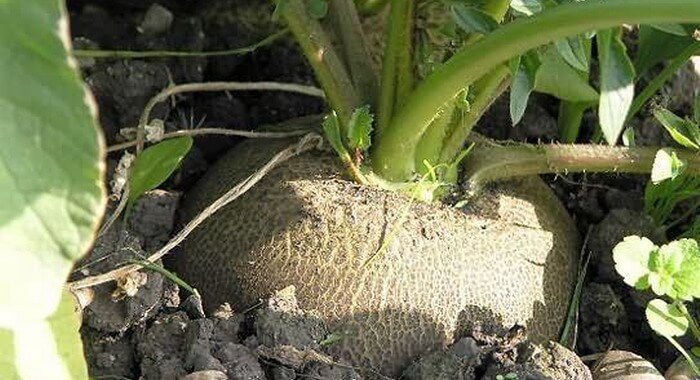
Plants do not adapt well to new places. Therefore, seeds harvested from sweet radishes are unlikely to give a tasty and sweet harvest. Bringing out sweet types of root vegetables is considered a very great achievement.

